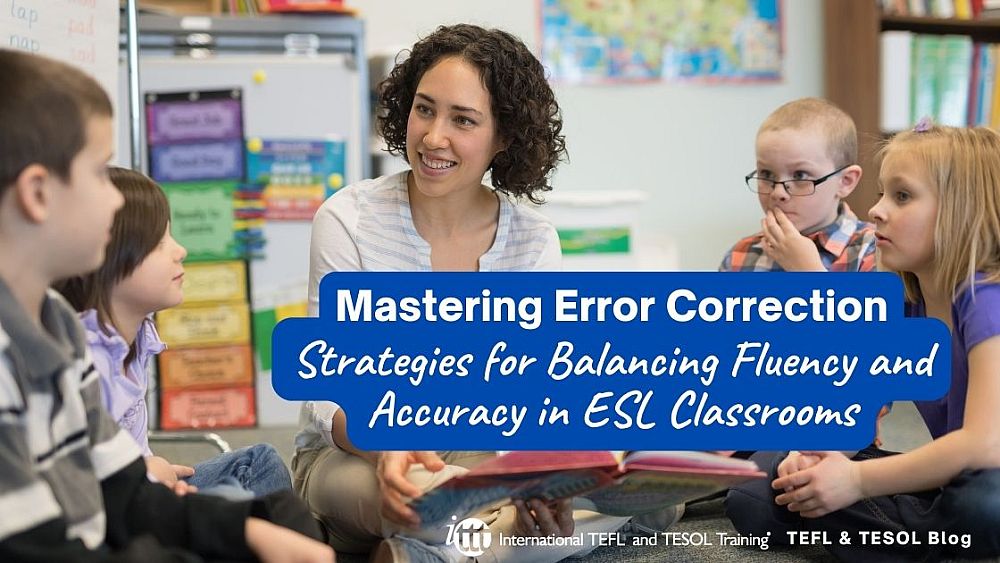Mastering Error Correction: Strategies for Balancing Fluency and Accuracy in ESL Classrooms

Navigating the delicate balance between fostering language fluency and ensuring grammatical accuracy poses a perennial challenge in ESL classrooms. In this comprehensive guide, we delve into the nuanced world of error correction strategies, exploring how educators can address language errors effectively while nurturing the fluency and confidence of their students. From distinguishing between errors and mistakes to crafting a three-stage correction process, join us on a journey through practical methods and considerations for creating a supportive and growth-oriented learning environment in ESL settings.
Table of Contents
Are You Working on Accuracy or Fluency?
Approaches to Error Correction
Ready to teach English as a Foreign Language?
Check out what our course grads say in our many video testimonials!
Errors or Mistakes?
Let's first differentiate between an error and a mistake.
\An error may be defined as something that indicates a deficiency in knowledge, typically grammar, which the student will continue to repeat until made aware of the error. This differs from a mistake, which is usually a temporary lapse in memory or due to tiredness or other factors. Mistakes are often immediately noticed by the speaker and self-corrected. If we are certain that the students are demonstrating errors, we can work on addressing the knowledge they need to overcome those situations.
Are You Working on Accuracy or Fluency?
The second point to consider is when to address errors. For example, if you are using the communicative language approach to teaching, different areas of focus will depend on the stage of the lesson.
Examples include the Presentation, Practice, Production method (PPP) and the Engage, Study, Activate method (ESA). In these methods, the Production phase of a PPP lesson and the Activate phase of an ESA lesson emphasize language production and fluency. Conversely, the Practice (PPP) and Study (ESA) phases focus on accuracy of language. Therefore, in a PPP (Production) and ESA (Activate) where fluency is our goal, we would be less likely to point out errors. In the PPP (Practice) and ESA (Study), however, if we notice errors, addressing them becomes essential as accuracy is our main goal here.
Correction Process:
It can be challenging not to correct immediately upon hearing a language error, and we should exercise caution in doing so, as overcorrection may reduce student confidence.Keeping the previous points (from #2) in mind, we suggest a process if you decide to correct, with the last point being the correction itself.
This involves a three-stage process to correct an error:Self-correction -> Peer correction -> Teacher correction
Self-correction
When you notice the error, provide an immediate non-verbal clue (such as a questioning glance) to the student that an error has occurred. You might opt to address the error in general feedback, verbally repeating it to the student or writing it on the board and asking the student who made the error, "Is this correct?"
Peer correction
If the student who made the error cannot correct it, open the question to the class to identify and rectify the error.
Teacher correction
Only step in to correct the error if neither of the previous steps yields a correction.
By consistently applying this correction method, students quickly learn the process and appreciate the opportunity to resolve errors before direct teacher correction.
Approaches to Error Correction
a. Student repetition:When a student verbalizes an error, ask them to repeat what they said and halt them at the point of the error.
b. Facial expressions and body language:Utilize a questioning facial gesture or an expression of surprise when an error is noticed to alert the student.
c. Reformulation:When correcting a student's error, as the teacher, rephrase the sentence provided and correct the error, either verbally or on the board.
d. Noting:It can be helpful to jot down errors made in class on a section of the board for later addressing. This is particularly useful if the focus is on fluency rather than accuracy at the time the error occurs.
Conclusion
In conclusion, the art of error correction in ESL classrooms hinges on a strategic blend of patience, awareness, and tailored approaches. By distinguishing between errors and mistakes, understanding the nuances of fluency versus accuracy, and implementing a structured correction process, educators empower their students to learn from their errors while bolstering their language skills. Embracing these diverse strategies not only cultivates a supportive learning environment but also equips students with the tools to navigate linguistic challenges with confidence, fostering a dynamic and enriching educational experience in the realm of ESL teaching.
Ready to teach English as a Foreign Language?
Apply now & get certified to teach english abroad!
Speak with an ITTT advisor today to put together your personal plan for teaching English abroad!
Send us an email or call us toll-free at 1-800-490-0531 to speak with an ITTT advisor today.
Related Articles:
- Top 10 Cities in Europe with the Highest Demand for English Language Teachers
- 5 Reasons To Take A TEFL Course Right Now - Even If You Are Not Leaving Yet | ITTT | TEFL Blog
- All the Documents You Will Need to Teach English Abroad
- The Impact of Positive Motivation on an ESL Classroom
- You're Never Too Old to Change Your Life and Do a TEFL Course | ITTT | TEFL Blog
- Getting Student Placement Right - The Best Desk Arrangements for EFL Students



